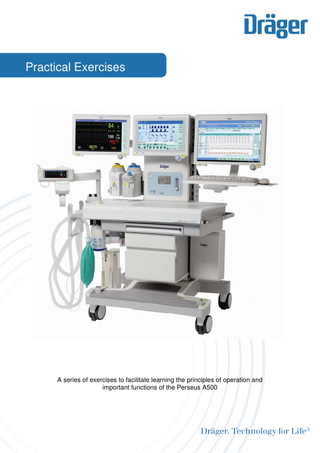Dräger Medical
Perseus A500 Practical Exercises ver 2.0
Practical Exercises
8 Pages

Preview
Page 1
Practical Exercises
A series of exercises to facilitate learning the principles of operation and important functions of the Perseus A500
Practical Exercises The purpose of these exercises is to familiarise you with the operation of the device. During the exercise, anaesthesia will be simulated While walking around the device once, explain all of the key elements. The system is in Standby. Connect a test lung. We want to set the system to spontaneous mode and simulate anaesthesia. 1. Go to: Start, New adult The data of the previous patient is deleted. Enter age, weight and height. What do you think these parameters are used for? Age... Weight... Height…………………………………………………………………... 2. Set the device to the spontaneous breathing mode. Which steps are required? ………………………………………………………………………………….. What position should the APL valve be in? …………………………………………………………………………………..
3. Set the O2 concentration to 100% and the O2 flow to 6 l/min 4. Begin manual ventilation and ventilate the test lung How can you tell which mode you are in? ………………………………………………………………………………….. ………………………………………………………………………………….. 5. Set O2 to 50%, flow 3 l/min and carrier gas to air. What are the individual flow rates for O2 & Air? O2 flow Air flow
Practical Exercises Then set the carrier gas to N20 What are the individual flow rates now? O2 flow N20 flow
6. Change the O2 concentration to 25% in N20 and reduce the flow to the lowest value. What happens? ………………………………………………………………………………….. 7. Adjust the alarm limits to the following values MV Paw FiO2
lower: 2
upper: 4 l/min upper: 30 mbar upper: 60
8. You want to go to Vol. Contr. Autoflow and want to preset the values for the patients – how do you do this? ………………………………………………………………………………….. Set Vt = 300ml; Freq = 10; Ti: Te = 1:2; PEEP = 5. Start ventilation.
9. What do the following colours mean on the soft keys Light green ………………………………………………………………………………….. Dark green ………………………………………………………………………………….. Yellow ………………………………………………………………………………….. Grey …………………………………………………………………………………..
Practical Exercises 10. Change the volume to Vt = 500ml; a MV alarm should sound. Where can you switch the alarm to mute? What options do you have for changing the alarms? Method 1: ………………………………………………………………………………….. Method 2: ………………………………………………………………………………….. Set Vt back to 300ml. 11. You are in Volume mode Autoflow. Change the patient compliance using the test lung, How do the pressure and flow curves change? ………………………………………………………………………………….. …………………………………………………………………………………..
What was the compliance before? What was the vt before? What was the PIP before?
ml/mbar ml mbar
What was the compliance after? What was the vt after? What was the PIP after?
ml/mbar ml mbar
12. You have forgotten to write down the insp. O2 concentration during manual ventilation. Where can you find it? List the steps used. ………………………………………………………………………………….. ………………………………………………………………………………….. In order to obtain xMAC correctly, you wish to modify the existing set up by adding an age of 60 years. What should you do? ………………………………………………………………………………….. …………………………………………………………………………………..
Practical Exercises 13. The anaesthetic agent Isoflurane has run out. How can you tell? …………………………………………………………………………………..
14. Go to standby. How can you see this? ………………………………………………………………………………….. How much gas have you used? O2 Air N20 Iso
15. Switch off the device.
16. Switch the device on. Observe the screen and perform the entire system test exactly as instructed by the device. What is the leakage value? ………………………………………………………………………………….. System compliance? ………………………………………………………………………………….. O2 supply pressure? …………………………………………………………………………………..
17. The anaesthetist would like to have the curves in a different order. How can you do this during operation? ………………………………………………………………………………….. …………………………………………………………………………………..
Practical Exercises Now we will simulate a few device failures: 18. Set the device to Volume Control Autoflow Set O2 50%, flow 4 l/min, N2O as carrier gas Disconnect the O2 pipeline from the socket in the wall. What do you observe? What happens to the gas delivery? What information does the Alarm Info key provide? ………………………………………………………………………………….. …………………………………………………………………………………..
Reinsert the O2 pipeline and disconnect the N20 pipeline. What happens now? Re-insert the N20 pipeline. ………………………………………………………………………………….. …………………………………………………………………………………..
Simulate a power failure. Disconnect the mains plug. What happens? e.g. LED ………………………………………………………………………………….. …………………………………………………………………………………..
19. The water trap of the gas monitoring system is full. What do you do? ………………………………………………………………………………….. …………………………………………………………………………………..
20. Where you can see the status of the battery?
Practical Exercises 21. Emergency start up. The device is switched off. Set Add O2 delivery to 6l/min. Set the APL valve to 15mbar. Connect the patient. Ventilate the patient manually What is the ventilation pressure? ………………………………………………………………………………….. Can the patient be given N20? Can Isoflurane be given? Switch on the device. Cancel the self test. Can you ventilate the patient the entire time? Start the ventilator in pressure controlled ventilation. Start gas delivery in fresh gas mode with 50% O2 in N20.
Practical Exercises
Draeger Medical UK Ltd The Willows, Mark Road Hemel Hempstead Herts, HP2 7BW T: 01442 213542 F: 01442 240327 E: med-marketing.uk@draeger.com W: www.draeger.co.uk Version 1.0 Reference number ATT023